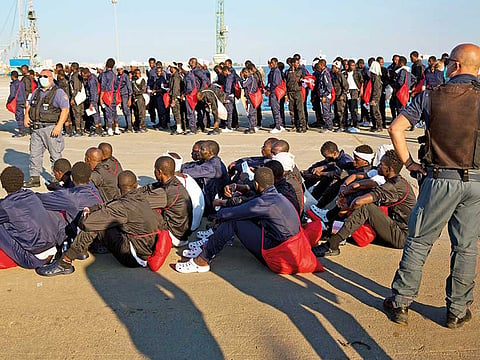Italy overwhelmed by flood of immigrants
Italian officials consider barring ports to vessels carrying immigrants after rescuing 12,000 refugees in four days

Brussels: More than 12,000 immigrants have been rescued in the blue seas of the Mediterranean in the past four days, a spike that has some overwhelmed Italian policymakers threatening to partly bar their ports to rescue ships.
The drastic step would, in theory, force ships bearing people fleeing wars and economic deprivation to find other places to dock, shifting some of the burden of Europe’s grinding refugee crisis to nations such as France and Spain. Both nations are on the Mediterranean Sea, but they are far more distant from Libya, through which nearly all the migrants are passing.
The proposal probably is a bargaining position taken ahead of a meeting of European migration ministers next week to discuss the continent’s challenges.
But it is also a reflection of Italy’s years on the migration front lines with little help from the rest of Europe. More than 82,000 people have arrived in Italy this year, a 20 per cent increase over the same period last year, according to the United Nations refugee agency. Refugee flows into Greece from Turkey have mostly dried up, meanwhile, a result of a March 2016 deal with Ankara to halt the traffic.
“With this frequency and these numbers we can easily tell that, soon enough, we won’t be able to handle it any longer,” said Nicola Latorre, the chairman of the defence committee of the Italian senate. “We need to act now, and what can immediately be done is to allow vessels that are not flying the Italian flag to carry those migrants to their respective countries.
“We risk reaching a point when we won’t be able to authorise any landing any longer, a dramatic situation,” he said.
Under current EU rules, asylum seekers are supposed to apply for protection in the first EU country that they enter. At the height of the refugee crisis in late 2015, EU leaders set up a quota system to try to distribute some of the refugees from the main arrival nations of Greece and Italy, but it has barely gotten off the ground.
The influx has strained Italian infrastructure — and the goodwill of Italian voters.
Italian citizens, once relatively friendly to refugees, rejected many politicians seen as soft on immigration in local elections on Sunday. Anti-immigration hard-liners were much more successful, putting pressure on the country’s ruling centre-left Democratic Party to be seen to ease the crisis.
“The message is that of a country that is not breaking the rules, but is coming under pressure and is asking for a concrete contribution from its European counterparts,” Italian Prime Minister Paolo Gentiloni said on Thursday alongside other European leaders in Berlin as they prepared for the Group of 20 summit of world powers next week.
“The migrant influx is not stopping. Unless you help us, the danger is that the populists will win the next general election in Italy,” Gentiloni said, according to Italy’s La Stampa newspaper.
Gentiloni has special ammunition in his effort to convince other European leaders to ease pressure on Italy — the spectre that euroskeptic populist parties could seize power in a national election due to be held by spring 2018. The ruling party has been slipping in opinion polls.
Italy and Greece “cannot be left alone in this refugee crisis”, European Commission President Jean-Claude Juncker told reporters on Friday in Tallinn, where he was meeting senior officials as Estonia takes up the rotating six-month presidency of the European Union. Commission officials have been sympathetic to Italy’s request that other nations accept rescue boats, although it is unclear whether Italy could actually bar its own ports legally or practically. One alternative proposal is that the EU channel more funding toward Italian refugee efforts.
Europe has also been training the Libyan Coast Guard — an effort made more difficult by the chaotic state of Libya’s government. And Italy signed a deal with Libya to turn back some refugees to Libyan camps, a step that has been criticised by refugee advocates because of the dangerous conditions in those largely lawless centres.
Although this year’s numbers are higher than last year’s, they are not unmanageable, refugee advocates say. But many of the rescues have clustered together, partially because of weather on the sometimes choppy Mediterranean and partly depending on the pace that smugglers can procure boats to pack with refugees.
The spikes can pose a challenge for rescue boats, which are a motley collection of Italian Coast Guard vessels, private ships hired by aid organisations and a five-ship effort by Frontex, the European border guard agency.
“It is really a challenge to save all these people, because they are pushed out at sea all together in a massive way,” said Carlotta Sami, a spokesperson for the UN refugee agency in Rome.
Some policymakers have criticised the rescue organisations, saying that their efforts to send ships to patrol the Mediterranean have actually become a key enabling step for smugglers, since no ships actually make landfall on Italy.
Rescue organisations reject that reasoning, saying that conditions in home countries tend to be more important in determining whether someone will try to make the journey to Europe than the number of ships plying the Mediterranean. The organisations say they have a moral duty to do everything they can to save lives.
More than 2,000 people have died so far this year as they tried to cross the Mediterranean, according to UN figures.
“We think rescuing human life is paramount,” said Joel Millman, a spokesperson for the International Organisation for Migration. He said that at moments in recent years when there were fewer rescue ships at sea, “there was no change in the pattern of sea arrivals.”
Sign up for the Daily Briefing
Get the latest news and updates straight to your inbox



